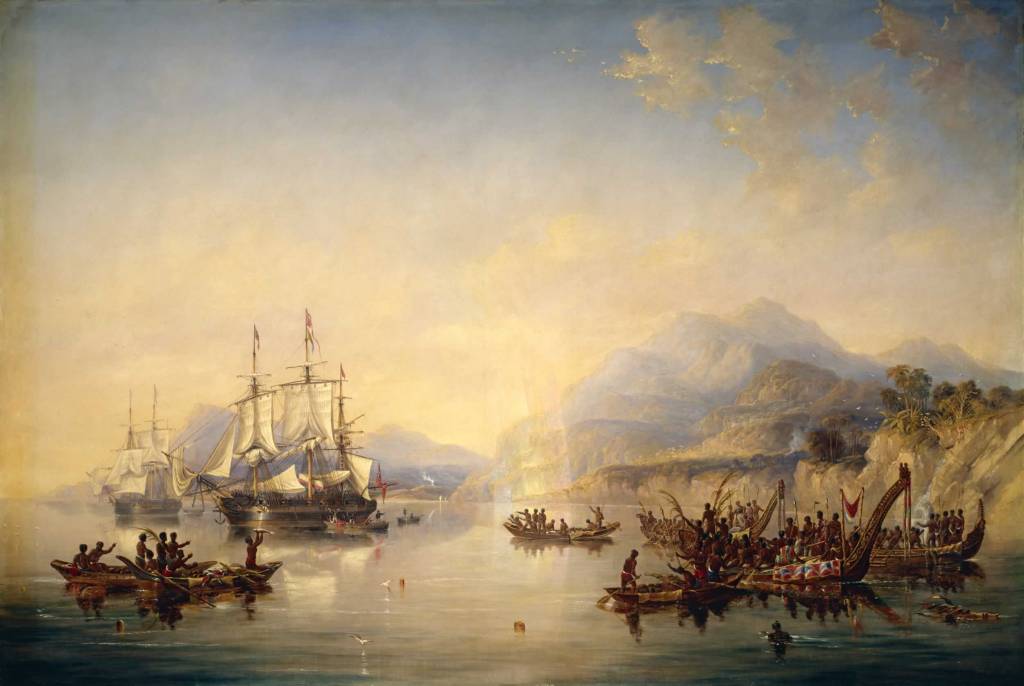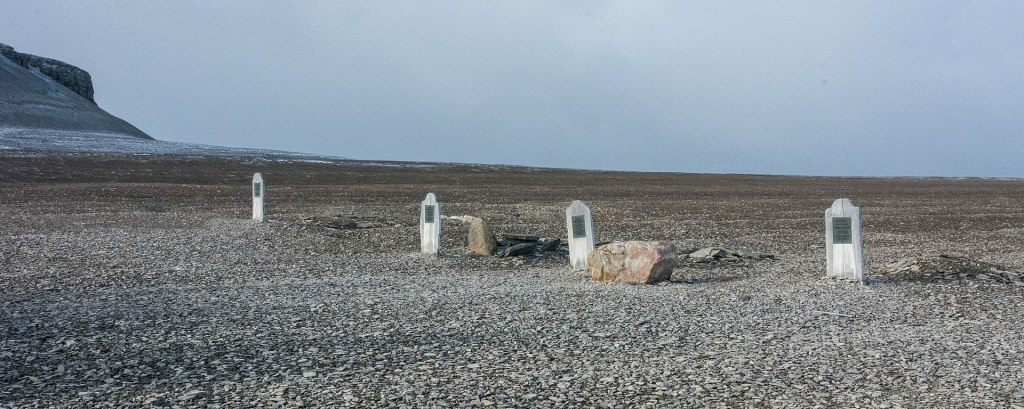In 1845, British explorer Sir John Franklin took two ships and 129 men on an expedition to find the fabled Northwest Passage. If found, the passage would offer a shipping route through the Canadian Arctic that would open up a much faster trade route to Asia. After both ships became trapped in ice for more than a year, every member of the expedition was lost.
By 1845, the Royal Navy had been mounting expeditions to find the Northwest Passage for forty years without success. Collectively, previous expeditions by land and sea had narrowed down an area where the passage might be found to an area of some 70,000 square miles.
Recruiting and Outfitting the Expedition
59-year-old Sir John Franklin was ultimately appointed to lead the expedition. In reality, Franklin was fairly low on the list of potential candidates assessed by Secretary of the Admiralty Sir John Barrow. First choice William Parry turned him down, as did second choice James Ross, who had promised his wife he was done with polar exploration.

His third choice was overruled as being too young, while his fourth and fifth were ruled out as too argumentative and as being of too humble birth, respectively. Eventually, Barrow appointed Franklin, albeit reluctantly. Despite Barrow’s reservations, Franklin had solid experience as a polar explorer, taking part in three previous expeditions and commanding two of them.
The expedition would be carried in two ships, HMS Terror and HMS Erebus. Both former bomb ships, each had been refitted for polar exploration. The robust design of bomb vessels to withstand the recoil of the heavy mortars they were fitted with made the two ships better able to withstand sea ice. Terror had previously been used on an Arctic expedition to Hudson Bay, where she was trapped in ice for 10 months, and nearly sank by an iceberg on her return journey. Both ships had previously taken part in the Ross Expedition in 1839 into the Antarctic.

Before departing, both ships were refitted with steam engines taken from locomotives, as well as an internal steam heating system to protect the crew from freezing Arctic conditions. Iron plating was bolted to their hulls to better protect them from sea ice. Both were stocked for a lengthy voyage, carrying large amounts of tinned food, alcohol and other supplies. In total, a three-year supply of food was loaded. The crew was recruited largely from Northern England. In total, only six officers had previous experience in polar regions.
Franklin departed from Greenhithe, Kent, on 19th May 1845, accompanied by 24 officers and 110 crew. It took 30 days for them to sail to Greenland. Stopping at the Whalefish Islands in Disko Bay, Greenland, the expedition sent back letters from the crew along with five members who had been taken ill on a transport ship, the Baretto Junior. These letters recount that Franklin was a strict leader, banning swearing or drunkenness amongst the crew. The expedition’s last contact with any other people was in July 1845, where they encountered two whaling crews in Baffin Bay while waiting for good conditions to cross Lancaster Sound.
The Victory Point Notes
Given the deaths of every member of the expedition, the events that followed are less than certain, and have been painstakingly pieced together by historians and researchers in the years since. The only written evidence to surface is a note found 11 years later at a location known as Victory Point. The note had been placed in a cairn on the coast of King William Island. It consisted of two letters, one written in 1847 after the ship had been trapped in ice for more than a year, and a second written a year later.

The first note, written by First Lieutenant Gore, stated that Erebus and Terror had been trapped in ice throughout the winter of 1846-47, but Franklin was still in command of the expedition and all was well. The second, dated 25th April 1848, read that the ships had been trapped since 12th September 1846, and that 105 of the officers and men remained. Amongst the 24 dead was Franklin himself, who had died on 11th June 1847.
Archaeological evidence suggests that Franklin’s expedition spent the winter of 1845-46 on Beechey Island, where three of them were buried. The ships were freed during the summer, but became trapped again off King William Island in September 1846. After Franklin’s death, the remaining crew eventually abandoned the ships and set out to walk across the sea ice back to the Canadian mainland, setting out on 26th April 1848. Most of the men that set out are thought to have succumbed to hunger, cold and fatigue during the 250 mile march. Between 30 and 40 reached the northern Canadian coast before succumbing.
Search Efforts Begin
After two years without word from Franklin, his wife urged the admiralty to send a search party. In the spring of 1848 a rescue party set out overland down the course of the Mackenzie river, while two seaborne expeditions launched from the Atlantic and Pacific Canadian coasts. All three failed to find any trace of the missing ships or men, fueling media speculation back in Britain about what had become of the lost expedition. A reward of £20,000 encouraged many more to join the search, and by 1850 11 British and two American ships had set out to find Erebus and Terror. At least one stopped on Beechey Island, where they found the remains of the expedition’s first winter camp and the graves of three crew.

In 1854, a search party commanded by Scottish surgeon John Rae encountered native Inuit in what is now Nunavut, Canada. They told him that they had found a party of between 35 and 40 white men who had died of starvation near the Black River. They also claimed that the desperate sailors had practiced cannibalism, as well as showing Rae objects they had recovered from the men. Some of these items were identified as belonging to Franklin and other members of the expedition.
A year later, two searchers travelling by canoe along the Black River also encountered local Inuit. They again described a group of white men who had starved to death on the coast. A piece of wood inscribed Erebus and another with the name of the ship’s surgeon were found on an island at the mouth of the Black River. The Admiralty ruled the men of the expedition deceased in March 1854, ending the search. Franklin’s wife however personally funded a further expedition. It was members of this expedition that eventually found the notes at Victory Point.
The same expedition eventually found a skeleton on King William Island, carrying a seaman’s certificate naming him Chief Petty Officer Henry Peglar. On the same island, a lifeboat was found containing two skeletons and items from the Franklin Expedition. Expeditions in 1860 and 1869 found the remains of a campsite and graves on the coast of the Canadian mainland, while Inuit also guided the latter party to a grave containing further skeletons.
Modern Research
The search for answers has continued in the modern era. A 1981 excavation by the University of Alberta studied artifacts and remains, finding evidence that the men had suffered from scurvy and had likely resorted to cannibalism given cut marks on some bones. Analysis also found lead levels in the men’s bones to be 10 times what would normally be found. It has been theorised that the lead soldering that sealed the expedition’s tins of provisions may have been responsible, or the ship’s distilled water systems.
Searches have continued ever since, with numerous teams finding additional items, graves and evidence of cannibalism. The wreck of HMS Erebus was finally found on 7th September 2014, at the bottom of Wilmot and Crampton Bay. Two years later, the wreck of HMS Terror was found south of King William Island, in what is now known as Terror Bay.

One man who had taken part in the search for the Franklin Expedition, Robert McClure, led a new expedition in search of the Northwest Passage in 1850. While his ship, HMS Investigator, was trapped in ice and abandoned, he later linked up with a second Royal Navy ship, HMS Resolute. He was then able to complete the first transit of the Northwest Passage. The passage was not travelled in its entirety using a single ship until 1906, after renowned Norwegian explorer Roald Amundsen completed a three year journey.
Man Proposes, God Disposes
The painter Edwin Landseer was inspired by the search for Franklin’s expedition to paint his 1864 work Man Proposes, God Disposes. The image depicts two polar bears picking over wreckage from the expedition, including a telescope and a tattered red ensign.

The painting is part of the collection owned by Royal Holloway, University of London, where it hangs in a hall used by the university for final exams. There is a long-standing belief amongst students that the painting is haunted, and anyone that sits their exam in front of it will fail. A common version of the story is that during the 1930s, a student stabbed his pencil through his eye during an exam, after scribbling ‘the polar bears made me do it’ on his paper. The story generally goes that he later committed suicide, but the event is not included in the university records.
While this incident is likely an urban myth, there is a long-standing tradition that the painting is covered with a Union Jack during exams. This practice began during an exam in the 1970s after a student insisted that the painting be covered before they sat their test. An invigilator covered it with a flag as it was the only thing to hand large enough to obscure it.

A most intriguing post. Have you ever read The Terror by Dan Simmons? It’s about the Erebus and Terror expedition, blending historical fact with fiction. In paperback, it’s over 900 pages but well worth the read.
I had no idea about the painting. Thanks for sharing!
LikeLiked by 1 person
I have, really enjoyed it. Funnily enough, I am currently reading another from Dan Simmons, The Abominable. It was actually the (excellent) TV version of The Terror that prompted me to write this blog.
LikeLiked by 1 person
I’ve read The Abominable, too. Another excellent book.
I only saw the first episode of The Terror. I need to track it down and catch up with it. The book is one of my all time favorite reads. I really enjoyed the blog post and your research.
LikeLiked by 1 person
Thanks very much!
LikeLiked by 1 person
I had not known the story of Franklin’s ill-fated expedition until I read your excellent article. Kudos to Franklin’s wife with everlasting hope of finding her husband’s whereabouts as well. On a personal note, the ship’s name HMS Terror was an omen itself and carried its curse to the painting itself. The article is replete with suspense and horror, making it eye-catching movie material. Many thanks for the share.
LikeLiked by 1 person
Thanks Stephanie. Definitely seems like an ill-fated name, particularly as Terror’s sister ship Erebus is named after a region of the underworld in Greek mythology, as well as the personification of darkness.
LikeLiked by 1 person